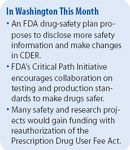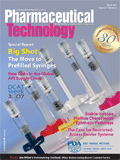Accelerating Drug Development
FDA's new safety program, Critical Path Initiative, and user-fee proposal seek to reinvigorate pharmaceutical R&D.
Doom and gloom have settled on the pharmaceutical industry. Pfizer recently announced it is closing manufacturing sites and research centers and cutting 10,000 jobs because of declining profits, stagnant sales, and a dry pipeline. Lower revenues and profits at Bristol-Myers Squibb have fueled talk of a merger or takeover. AstraZeneca is eliminating 3000 jobs and restructuring manufacturing and research and development (R&D) operations to offset losses from looming generic competition. At the same time, Democratic leaders in Congress are increasing the rhetoric about too-high drug prices, drug safety problems, excessive drug advertising, and the need to expand access to more generic products, particularly for biotechnology therapies.

These developments have raised hurdles for bringing new medicines to market. A December 2006 report from the Government Accountability Office describes the declining productivity of the pharmaceutical research enterprise. Industry increased R&D spending from $16 billion in 1993 to $40 billion in 2004, and estimates put the number at $60 billion last year. Yet, the number of new drugs being tested by manufacturers has declined, resulting in fewer important new molecular entities (NMEs) coming to market. The US Food and Drug Administration approved only 22 NMEs in 2006, including new biologics. The total has been flat in the past few years, but is "way off the historic highs of the mid-1990s," commented Steven Galson, director of the Center for Drug Evaluation and Research (CDER) at the January Well Characterized Biotechnology Pharmaceutical meeting in Washington, DC.
What is most distressing is that drug pipelines have dried up at a time of rapid biomedical discovery. Breakthroughs in genomic and molecular research and in bioinformatics were supposed to usher in a period of unprecedented progress in drug development. FDA has been working hard to harmonize regulations, streamline the approval process, and provide more guidance for industry. And, manufacturers have moved to modernize quality-testing and production systems, to streamline research processes, and to reduce wasteful production methods. While these efforts have drawn applause, they have been offset by a focus on drug safety that has prompted both regulators and manufacturers to expand the scope of clinical trials and new-product testing. Some important new drugs and vaccines did come to market last year, but the average cost of developing a new drug now hovers at the $1-billion mark.

Jill Wechsler
Spotlight on safety
In an effort to deal with these issues, FDA Commissioner Andrew von Eschenbach unveiled a plan that addresses many of the drug-safety issues raised in last year's scathing Institute of Medicine (IOM) publication demanding major changes to better balance FDA's assessment of risks and benefits. The FDA report on The Future of Drug Safety outlines proposals to develop safety "report cards" on important new drugs, to post an online drug-safety newsletter, and to expand its access to health-system databanks to detect safety signals more quickly. Galson also promised a "true culture change" to address the tension between pre-and postapproval staffs.
The unstated goal is to head off legislation requiring more significant organizational changes and added mandates for manufacturers and regulators alike. Senators Charles Grassley (R-IA) and Chris Dodd (D-CT) recently reintroduced legislation to establish a separate drug-safety office at FDA. And, Senators Edward Kennedy (D-MA) and Mike Enzi (R-WY) proposed their drug-safety bill that requires risk-mitigation strategies for all new drugs and mandates clinical-trial registration.
The FDA announcement covered activities that the agency can implement on its own, provided it receives added resources from user fees and appropriated funds. If FDA and industry want Congress to reauthorize the Prescription Drug User Fee Act (PDUFA) by fall, however, they probably will have to accept some new requirements for ensuring drug safety.

In Washington This Month
More disclosure
The FDA plan addresses many of the IOM recommendations for improving how it assesses and communicates risk information, although not always in the way the expert panel suggested. Experts have clamored for FDA to make public more drug-safety information from postapproval studies and adverse-event reports, but industry has opposed the idea of posting emerging safety information before it is fully evaluated by sponsors and regulators. Instead of launching a "Drug Watch" Web site that would have posted emerging safety information, FDA now proposes to publish an on-line newsletter with summaries of FDA postmarketing drug reviews, new safety concerns, and information about newly approved products. The postings will be cleansed of confidential commercial information, however, and FDA does not plan to disclose supplement reviews.
Instead of establishing some kind of conditional approval for new drugs, which probably requires legislative change, FDA is launching a pilot plan to re-evaluate newly approved drugs after a year on the market. The agency will review adverse-event reports and additional information for two or three NMEs in a pilot program that will issue its first assessments in about 18 months. The reports will be made public, and the pilot could be extended to all new drugs if it succeeds in providing a more complete picture of safety issues throughout the product life cycle.

Fees for safety
A central issued raised by the IOM is that CDER's pro-approval culture relegated safety reviewers to a secondary role in evaluating the risks and benefits of new drugs. Galson plans organizational changes that will give CDER's Office of Surveillance and Epidemiology staff a clear role in approving new drug applications (NDAs) and requesting postmarket studies and future label changes. Each new drug-review office will have a high-level safety manager, and a new electronic tracking system will integrate multiple agency databases.
A leading legislative proposal requires all NDAs to include risk-management plans, and the IOM report urges further evaluation of such approaches. FDA says it will assess the effectiveness of RiskMAPS and publicly review one or two risk programs every year to better determine whether RiskMAPS or other approaches can improve public awareness of serious safety issues.
FDA also is expanding programs to use emerging electronic health-information systems to gain more information about drug use and health outcomes. The agency is collaborating with the Veterans Administration, Medicare, and other government agencies to access data on medical-product use in federal healthcare systems. A proposed FDA Sentinel Network would link private and public databases to establish a national medical-product safety network.
Stress on science
An underlying theme of FDA's drug-safety program is that new developments in biomedical science can detect risk issues early in development. FDA Deputy Commissioner Janet Woodcock, now the agency's chief medical officer, heads a range of efforts to accelerate risk assessment by sponsors and FDA, many launched under the Critical Path Initiative.
For example, FDA is collaborating with industry and academia about developing new tests for organ toxicity and for identifying the cardiovascular risk of drugs. The Predictive Safety Consortium is sharing data to crossvalidate preclinical safety biomarkers. Another consortium of manufacturers, FDA, and the National Institutes of Health (NIH) plans to assess biomarkers that can spur development of new treatments, beginning with lung cancer and lymphoma. And, a new Serious Adverse Event Consortium seeks to identify and validate genetic variants that may help predict the risk of drug-induced reactions, starting with liver disease and serious skin rashes.
These efforts to improve clinical-program success rates and reduce development time and cost were described in FDA's Critical Path Opportunities List, which was issued in March 2006 and updated in a January 2007 report on collaborations and research activities undertaken in 2006. The aim is to "build safety into products" by better understanding the genetic basis of adverse events, explained Woodcock. These approaches can screen out toxic compounds early on and identify patients most likely to have adverse events—or to respond well—to a test medicine. FDA, she said, wants to "make products safer from the get-go."
Modernizing manufacturing
This campaign includes several projects designed to "move manufacturing into the 21st century" by developing standards for laboratory and production analytical methods. To encourage the adoption of process analytical technology, for example, FDA is partnering with pharmaceutical and instrument manufacturers to test validation reference systems. The aim is to establish specifications for imaging methods such as near-infrared, mid-infrared, Raman chemical imaging (RCI), and terahertz technologies. Standards that ensure proper calibration and instrument qualification would lead to FDA guidance for adopting such methods in continuous quality-controlled manufacturing processes.
Other collaborations with industry and academia aim to ensure that policy development, training, and regulatory practices are consistent with state-of-the-art science. FDA has signed Cooperative Research and Development Agreements (CRADAs) with Pfizer and Novartis to expand understanding, and ultimately control, of material transformation. Another CRADA with Conformia Software seeks better understanding of the challenges and bottlenecks that influence pharmaceutical development. Additional PAT-related research ventures involve FDA and Duquesne University, the Center for Pharmaceutical Processing Research, the National Institute for Pharmaceutical Technology and Education, and the Engineering Research Center for Structured Organic Composites.
New dosage forms. FDA also is encouraging new standards and methods for novel drug dosage forms to expand options for drug delivery. One project aims to refine and validate the use of RCI to establish scientific standards for chemical identity, particle size, and distribution characteristics of active pharmaceutical ingredients in aqueous nasal-spray suspensions. If successful, this approach could be applied to dry-powder and metered-dose inhalers. Another FDA–industry collaboration is developing methods to assess the adhesive properties and permeation of various transdermal products. The objective is to compare drug diffusion and skin permeation through different in vitro methods, an exercise that eventually could lead to American Society for Testing and Materials standards and agency guidance for these products.
FDA also is working to characterize liposomal drug products for their encapsulation efficiency, leakage, and particle size. The project involves testing performance under various physiologic stress factors, with an eye to developing in vitro cell-line bioassay methods to assess changes in liposomes under different conditions.
Laboratory standards. A high-profile project is to establish standards for multi-color flow-cytometry measurements in various laboratories and across instrument platforms. Because flow-cytometry data are important for developing many medical products, FDA is collaborating with instrument makers and the National Institute of Standards and Technology (NIST), the Centers for Disease Control and Prevention, the Environmental Protection Agency, the NIH, the International Society of Cytometry, and the Clinical Cytometry Society to develop, test, and validate standards that will ensure comparability of such measurements.
Similarly, a Microarray Quality Control Project involving scientists at federal agencies, academia, and pharmaceutical companies is testing the reliability of microarray tools in measuring gene expression. Initial tests showed that these data can be reproducibly measured across multiple drugs and laboratories.
Biotechnology improvements. Several projects seek to modernize vaccine production. FDA is supporting research to shift influenza-vaccine production from egg-based systems to cell-culture substrates and to establish libraries of possible pandemic influenza virus strains to help manufacturers test new vaccines for potency and efficacy more quickly. These projects can support efforts to produce safe and low-cost vaccines for developing countries such as new vaccines for meningitis and tuberculosis. FDA scientists also are collaborating on research to evaluate the efficacy of mumps vaccines and to develop biomarkers to evaluate the stability and safety of future vaccines for malaria and leishmaniasis.
Related efforts aim to improve the safety of biotechnology manufacturing processes, including those used in vaccine production. An FDA collaboration with the National Institutes of Allergy and Infectious Diseases is examining methods for detecting infectious contaminants in cell cultures and whether such contaminants increase the risk of causing tumors. Additional projects seek to improve the characterization of complex biological products. FDA is exploring how to adapt high-tech imaging methods such as nuclear magnetic resonance spectroscopy to better characterize glycoprotein vaccines, allergen extracts, and other complex products. Similarly, a collaboration of FDA, NIH, and other partners is evaluating how well new microarray technologies and other tools can better predict the quality of cell substrates used to manufacture vaccines, protein drugs, and gene vectors. The discovery of specific gene-expression patterns or the identification of clusters of specific genes may help characterize cell substrates and serve as biomarkers of manufacturing quality.
Testing and analysis. FDA also supports efforts to understand more fully how nanotechnology may contribute to the development of new treatments. FDA is collaborating with NIST and the National Cancer Institute Nanotechnology Characterization Laboratory to develop characterization assays and methods for preclinical and early clinical testing of such products as a way to better understand their promise for providing more effective and less toxic cancer therapies. FDA has established a Nanotechnology Task Force and Nanotechnology Interest Group of review scientists with expertise in this area to provide input on product development.
And, as part of efforts to prevent the spread of transmissible spongiform encephalopathy, or mad cow disease, FDA scientists are collaborating with colleagues in other government agencies, academia, and industry to develop and assess technologies able to identify prion contamination of biological products. Such tests could be valuable in ensuring the purity of biotechnological manufacturing processes, as well as for screening blood and tissue.
Jill Wechsler is Pharmaceutical Technology's Washington editor, 7715 Rocton Ave., Chevy Chase, MD 20815, tel. 301.656.4634, jwechsler@advanstar.com

Pharmaceutical Tariffs Are Imminent: How Industry is Bracing for Impact
April 16th 2025On April 14, 2025, the Trump Administration launched a national security-driven investigation into pharmaceuticals, a move that will likely result in tariffs being placed on pharmaceutical drugs, ingredients, and other components that are imported from outside of the United States.